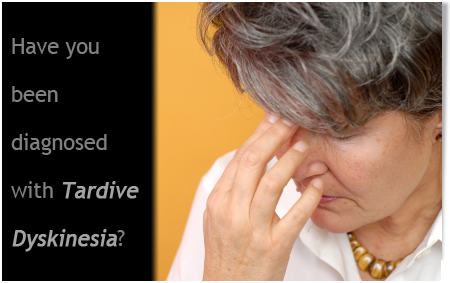
The nervous system is an extremely sensitive biological system which governs the entire body. Many factors can interrupt the delicate function of the nerve signals sent within the brain and to the rest of the body. Exposure to certain drugs can cause a person to develop a condition called tardive dyskinesia. In tardive dyskinesia, the neurons (nerve cells) misfire causing involuntary movements, particularly of the face and hands.
Symptoms of Tardive Dyskinesia
Frequently, a person with tardive dyskinesia will not immediately notice the symptoms.  Family members, friends, or medical personnel may be the first to notice that something is wrong. The following symptoms can be signs of tardive dyskinesia:
Family members, friends, or medical personnel may be the first to notice that something is wrong. The following symptoms can be signs of tardive dyskinesia:
- Grimacing involuntarily.
- Twisting the mouth.
- Protruding the tongue involuntarily.
- Sucking or chewing movements when there is nothing in the mouth to be chewed or sucked upon.
- Sometimes the facial movements resemble those of a person with poorly-fitting dentures.
- Lip smacking.
- Mouth puckering.
- Excess blinking or wrinkling of the forehead.
- Slow writhing movements (athetoid movement) of the hands, fingers, feet, or toes.
- Hand movements that resemble guitar or piano playing.
- Involuntary flexing of the feet and ankles.
- Tapping and/or wiggling of the toes and fingers.
- Some cases of tardive dyskinesia manifest themselves with jerking of the diaphragm and abdomen. This can disrupt breathing rhythms.
- In some patients, the neck or head may jerk.
If person’s attention is directed to these movements, he or she may be able to control them briefly. The involuntary movements may cease when deliberate movement of the affected body part is being carried out. For example, a person who is involuntarily wriggling the fingers may cease doing so when holding on to something.
What causes Tardive Dyskinesia?
A class of drugs called neuroleptics has traditionally been the main cause of tardive dyskinesia. Neuroleptics are given for psychiatric disorders, particularly for schizophrenia. These drugs were considered a great boon for schizophrenic patients when they were first introduced some fifty years ago. Neuroleptics can greatly reduce the symptoms of schizophrenia and they have helped many schizophrenic sufferers live more normal lives. Unfortunately, long term use of neuroleptics can result in tardive dyskinesia. Several other classes of drugs can also cause tardive dyskinesia. These include atypical antipsychotic drugs, antidepressants, antihistamines, anti-anxiety medications, Parkinson’s medications, oral contraceptives, and antiemetics (nausea and reflux control). The antiemetics are given for gastroparesis—a condition in which the stomach has difficulty contracting, making digestion difficult. Metoclopramide (an antiemetic sold under the brand names Maxolon and Reglan) is one antiemetic strongly linked to tardive dyskinesia. The antiemetic Prochlorperazine (brand name: Compazine) is also linked to tardive dyskinesia. Antiemetics, such as Reglan, are also given for other conditions. Reglan may be given to reduce nausea during chemotherapy for cancer. It may given to people with swallowing difficulties to reduce the chance of aspiration pneumonia (pneumonia caused by choking and inhaling food into the lungs). It is sometimes given to reduce nausea when a tube must be inserted into the stomach and it may be given to facilitate some forms of stomach x-rays. It is also given to treat headaches caused by a disorder of the cranial blood vessels. Numerous other serious side effects have been reported from taking Reglan. In addition to tardive dyskinesia it can cause depression, anxiety, and suicidal thoughts. Some patients have reported increased stomach pain when taking the drug. Generally, patients must be on a medication for three months or more before symptoms of tardive dykinesia appear; however, people over age sixty are at much higher risk of developing tardive dyskinesia and symptoms of the disorder may appear within a month or less after someone age sixty or older begins to take the drug. Symptoms may also first appear up to eight weeks after the drug is discontinued. African Americans are especially prone to developing tardive dyskinesia. Females are more prone to develop tardive dyskinesia than are males.
Diagnosing Tardive Dyskinesia
Doctors diagnose tardive dyskinesia by carefully observing the patient and asking key questions(such as how bothersome the symptoms are). Other conditions which can cause similar symptoms must be ruled out before a diagnosis of tardive dyskinesia is made.
Treatment for Tardive Dyskinesia
Treatment of a tardive dyskinesia prognosis varies according to the individual case. In many instances, the drug causing the problem can be discontinued or another medication which does not cause tardive dyskinesia may be substituted for it. In other cases medication for the symptoms of tardive dyskinesia may be necessary. In all cases, the patient should be evaluated to see if the benefits of the drug causing the problem outweigh the risks of tardive dyskinesia. The symptoms of tardive dyskinesia may disappear entirely once the cause is removed. In some cases, the symptoms may become milder and less noticeable, but continue to linger for the rest of the person’s life.
